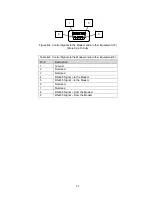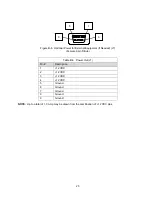
EQUIPMENT THEORY OF OPERATION
The 41800-002 RFMOW V2 acts as a data-switching and control device between various peripherals
including the satellite modem, secure voice unit, and COMSEC device. The RFMOW V2 can operate in 2
different modes:
•
Normal Mode- The RFMOW V2’s internal computer is used for control.
•
Interface Unit (or IU) Mode- An external computer is used for control.
Switching is controlled by the RFMOW Software that is installed on the controller computer.
Device Control
The J5 Modem Control connector on the rear panel of the Unit (see page 18) is the Controller Interface. The
controller computer utilizes the COM2 serial port to control the satellite modem within the RFMOW network.
Connector J5 is an RS-422 / RS-485 signaling device. The port can be used as a 4-wire port with separate
transmit and receive wires or as a 2-wire port with the transmit and receive wires tied together. When the
Unit is not transmitting, the transmit wires are open circuit.
“A / B” Switch Operation
In the NT mode of operation, it is necessary to switch between the voice and data paths. In order to control
the “A / B” switch on the RFMOW V2, the controller computer utilizes the COM2 serial port. To switch from
data to voice mode, the computer asserts the DTR line of the communications port. De-asserting DTR
returns Unit to data mode. This functionality is handled automatically using the RFMOW Software as
described in TM 11-5895-1780-13 Replacement Frequency Modulated Orderwire (RFMOW).
ALERT Horn Operation
The ALERT Horn is controlled by the RFMOW Software. The RFMOW Software asserts the COM2 RTS pin
to turn on the Unit’s ALERT horn. De-asserting the RTS pin turns the horn off.
Data Communications
KIV Data communications is controlled by the RFMOW Software. The RFMOW Software uses the COM1
serial port to interface with KIV RED data.
Voice Communications
Voice communication occurs by connecting a Secure Telephone device (STU or STE III) to J1 on the rear
panel of the RFMOW V2. DTR on COM2 must be asserted in order for the Unit to select the voice path on
the “A / B” switch. This is handled automatically using the RFMOW software.
10











































